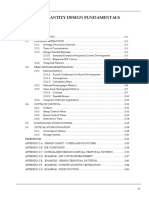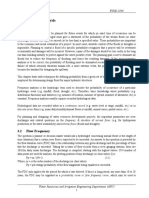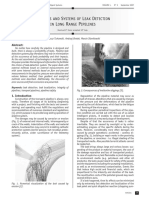Drainage Design Manual Section 3
Drainage Design Manual Section 3
Uploaded by
Kenneth KaratungaCopyright:
Available Formats
Drainage Design Manual Section 3
Drainage Design Manual Section 3
Uploaded by
Kenneth KaratungaOriginal Title
Copyright
Available Formats
Share this document
Did you find this document useful?
Is this content inappropriate?
Copyright:
Available Formats
Drainage Design Manual Section 3
Drainage Design Manual Section 3
Uploaded by
Kenneth KaratungaCopyright:
Available Formats
Drainage Design Manual
Section 3
TABLE OF CONTENTS
SECTION 3 : DESIGN FLOW CONSIDERATIONS..............................................................3.1
3.1 Introduction...................................................................................................................... 3.1
3.1.1 Average Recurrence Interval (ARI)........................................................................3.1
3.1.2 Exceedence Probability......................................................................................... 3.1
3.2 Design Flows................................................................................................................... 3.2
3.2.1 General.................................................................................................................. 3.2
3.2.2 Minor and Major Drainage Systems.......................................................................3.3
3.2.3 Selection of Design Average Recurrence Interval..................................................3.3
3.2.4 Environmental Impact............................................................................................ 3.4
LIST OF TABLES
Table 3.1 : Probability That An Event of a Given Recurrence Interval will be Equaled or
Exceeded during Periods of Various Lengths (Computed Employing
Eqn.
3.1)..................................................................................................................... 3.2
Table 3.2: Design Average Recurrence Intervals for Flood/Storm (Yrs) by Geometric Design
Criteria (Source: ERA Drainage Design Manual, 2002)......................................3.4
Ministry of Works, Housing & Communications
Drainage Design Manual
Section 3
SECTION 3
DESIGN FLOW CONSIDERATIONS
3.1 Introduction
Design of a drainage system involves determination of flow magnitudes which every
line in the system is to be designed for. Hydrologic considerations determine the flow
magnitudes or flow hydrographs, as the case may be, at each point in the drainage
system. The resulting flow hydrographs are then routed downstream according to
hydraulic principles.
Design flow is determined based on the statistical (frequency) analysis on historic
records of flow for gauged sites or rainfall and the associated hydrologic parameters for
un-gauged sites. Generally, the longer the length of data, the more reliable the
estimation of design flow will be.
3.1.1
Average Recurrence Interval (ARI)
As all magnitudes of flow have some chance of occurrence, the design flow is decided
by attaching an average recurrence interval. Average recurrence interval is defined as
the average interval in years between the occurrence of a flow of specified magnitude
or larger flow. It is the long term average of the intervals between successive
exceedences of a flow magnitude.
The word average is the important part of the definition of recurrence interval. As
hydrological events are generally random in their occurrences, it can not be inferred
that a flow of particular average recurrence interval is equaled or exceeded at regular
interval. This important point is also to be explained to decision makers and to the
public at large who are affected by them.
3.1.2
Exceedence Probability
Exceedence probability is the probability that an event of a given average recurrence
interval will be equaled or exceeded during a given period of time. Consideration of the
probability of exceedence during a given span of time, particularly the design life of a
structure can be used as an aid in the selection of the level of serviceability to be
provided.
Equation 3.1 is used to compute the probability J that at least one event which equals
or exceeds the t p -yr event will occur in any series of N years
J 1 (1 P ) N
Where:
Eqn. 3.1
1
tp
The probability that an event of a given recurrence interval will be equaled or exceeded
during periods of various lengths is depicted in Table 3.1
3.1
Ministry of Works, Housing & Communications
Drainage Design Manual
Section 3
Table 3.1 : Probability That An Event of a Given Recurrence Interval will
be Equaled or Exceeded during Periods of Various Lengths
(Computed Employing Eqn. 3.1)
Period, yr
tp, yr
10
25
50
100
200
500
1.0
*
*
*
0.98
0.87
0.63
1
*
*
*
*
0.993
0.92
Probability of being equaled or exceeded
1
2
5
10
50
100
200
1.0
0.5
0.2
0.1
0.02
0.01
0.005
1.0
0.97
0.67
0.41
0.1
0.05
0.02
1.0
0.999
0.89
0.65
0.18
0.1
0.05
1.0
*
0.996
0.93
0.40
0.22
0.12
1.0
*
*
0.995
0.64
0.4
0.22
1.0
*
*
*
0.87
0.63
0.39
*In this case the probability can never be 1, but for practical purposes its value may be
taken as unity
3.2
Design Flows
3.2.1
General
Design flow is defined as discharge that may be expected from the sever combination
of meteorological and hydrologic conditions that are reasonably considered to reflect
characteristics of the area involved, excluding extremely rare combinations.
Adequate storm water drainage system or adequate waterway is a system or a
waterway which has the hydraulic characteristics to accommodate the maximum
expected flow (design flow) of storm water for a given watershed or a portion/s thereof.
Adequate system/s:
1) should be designed to account for both off-site and on-site storm water, including
storm water coming into a given tract of land from upstream;
2) should discharge the flow in to natural drainage line or other appropriate outlets;
and
3) should carry water to a point where it should flow downstream into a stream
channel or water way.
Design flood standards are influenced by many factors including:
safety;
the level of hydraulic performance required;
environmental impact;
construction and operation costs;
maintenance requirements;
serviceability; and,
Legal and statutory requirements.
The standards are expressed by average recurrence intervals adopted. These
measures determine the magnitude of a design rainfall or runoff event with which the
system can cope. Past practice has often been based on one level of operation. But it is
usually appropriate to design for several performance levels which include:
3.2
Ministry of Works, Housing & Communications
Drainage Design Manual
Section 3
A maintenance requirement (frequent event), related to a short design average
recurrence interval;
A convenience or nuisance reduction requirement (infrequent event), one to five
years of average recurrence interval;
A flood damage prevention requirement (sever or rare event), 50 to 100 years of
average recurrence interval; and,
A disaster management requirement (extreme event), related to extreme events
such as probable maximum floods.
The first two are relevant to minor drains, and all but the second to major drains
discussed under 3.3.2.
Assigning an average recurrence interval takes into account the level of safety
(standard) required. The required level of safety in turn depends upon potential losses
to occur following the probable failure (both structural and serviceability) of an element
of a drainage system or a combination thereof. Generally, the longer the average
recurrence interval, the higher the magnitude of flow will be and the safer the level of
protection.
3.2.2
Minor and Major Drainage Systems
a.Minor Drainage System (span < 6.0 meters)
The minor system, sometimes referred to as the "Convenience" system, consists of the
components that have been historically considered as part of the "storm drainage
system". These components include curbs, gutters, ditches, inlets, access holes, pipes
and other conduits, open channels, pumps, detention basins, water quality control
facilities, etc.
The minor drainage systems are part of the total drainage system which are intended to
collect the maximum run off from the initial storm and convey runoff from frequent storm
events such that nuisance is minimised, while the major systems are intended to safely
convey runoff not collected by the minor drainage system to receiving waters.
b.Major Drainage System (span > 6.0 meters)
The major system provides overland relief for storm water flows exceeding the capacity
of the minor system. This usually occurs during more infrequent storm events. The
major system is composed of pathways that are provided for the runoff to flow to natural
or manmade receiving channels such as streams, creeks, or rivers.
The major system typically consists of a network of overland flow paths including roads,
natural channels and streams, engineered waterways, culverts, and detention basins
which ultimately discharge into receiving waters.
3.2.3
Selection of Design Average Recurrence Interval
The selection of design average recurrence interval values must be made by the
designer in relation to the cost of a facility, amount of traffic and expected level of
service; potential flood hazard to property; the magnitude and risk associated with
damages from larger flood events; and conditions for practical detour during probable
failure. In selecting a design frequency, all potential upstream land use for the
anticipated life of the drainage facility must be considered.
Review of existing drainage system should be carried out using the same general
sequence as planning and design of new drainage projects. The first step will take into
account the existing (constructed) drainage system. It is often found that older existing
systems are lacking considerations of the major system flows. Minor system is normally
3.3
Ministry of Works, Housing & Communications
Drainage Design Manual
Section 3
designed to carry runoff from up to 10 year frequency storm events. Major systems are
designed for floods of average recurrence intervals 25, 50, and 100-year.
The design frequency value depends on particular site and catchment conditions. This
being the case, the values rendered in Table 3.2 which is based on geometric design
criteria could be used for initial planning, design and analysis.
Table 3.2:
Design Average Recurrence Intervals for Flood/Storm (Yrs)
by Geometric Design Criteria (Source: ERA Drainage
Design Manual, 2002)
Structure Type
Gutters and Inlets*
Side Ditches
Ford/Low-Water Bridge
Culvert, pipe (see Note)
Span < 2m
Culvert, 2m < span < 6m
Short
Span
Bridges
6m < span < 15m
Medium Span Bridges
15m < span < 50m
Long
Span
Bridges
spans > 50m
Check/Review Flood
PIa = Paved Ia
PIb = Paved Ib
PII = Paved II
PIII = Paved III
PIa, PIb
10/5
10
25
Geometric Design Standard
PIII Gravel A
PIII, Gravel B
2
2
10
5
10
5
Gravel C
5
5
5
50
50
25
50
10
25
10
25
100
50
50
50
100
100
100
100
200
200
100
100
Note 1: Span in the above table is the total clear-opening length of a structure. For
example, the span for a double 1.2-meter diameter pipe is 2.4 meters, and
the design storm frequency is therefore culvert, 2m < span < 6m. Similarly
a double box culvert having two 4.5-meter barrels should use the applicable
design storm frequency for a short span bridge and a bridge having two 10meter spans is a medium span bridge.
All bridges and major culverts shall be checked for performance under a storm event
less frequent than the design storm event shown in the table as the Check/Review
Flood. All other drainage structures shall be checked for the storm having the next
lower frequency than the design storm event. For example, minor culverts designed for
a 10-year storm shall be checked for adequate performance with a 25-year interval
storm event.
3.2.4
Environmental Impact
a.Physical
There is no published information available on the average recurrence interval of the
flow that should be used for assessing and minimizing possible environmental damage.
Each site should be investigated for possible environmental impact that might occur
3.4
Ministry of Works, Housing & Communications
Drainage Design Manual
Section 3
with a range of flow events, with emphasis on the more frequent ones. The following
factors need be considered when assessing any potential environmental damage.
Selection of suitable site;
Provision of adequate opening to limit backwater effects and excessive localized
bed scour;
Protection of banks from erosion that comes as a result of redirection of flow,
turbulence or excessive increase in velocity;
Protection of natural vegetation, especially where it protects or stabilizes; and,
Control of road side drainage where it enters streams, to limit bank erosion.
b.Water Quality
When runoff flows, it collects pollutant loads. The variation of pollutants with time results
in pollutant-load graphs. The pollutant-load graphs are then routed downstream
according to hydraulic principles. Water quality may then be improved by natural
process or introduction of treatment devices. Because of the interaction between
hydrology, hydraulics, and water quality, all aspects need to be considered in an
integrated manner.
3.5
Ministry of Works, Housing & Communications
You might also like
- Elements of Urban StormwaterDocument234 pagesElements of Urban StormwaterEduardo Carvalho40% (5)
- Chapter 7-Frequency AnalysisDocument18 pagesChapter 7-Frequency AnalysisnimcanNo ratings yet
- Maccaferri Channel Design ManualDocument45 pagesMaccaferri Channel Design ManualHuy Le QuangNo ratings yet
- 7-1 Stormwater Drainage System DesignDocument3 pages7-1 Stormwater Drainage System DesignMuhammad IqbalNo ratings yet
- Chapter 3-Frequency AnalysisDocument18 pagesChapter 3-Frequency AnalysisGechNo ratings yet
- Chapter 3-Frequency AnalysisDocument18 pagesChapter 3-Frequency AnalysisSami ShimelisNo ratings yet
- Chapter 8-Frequency AnalysisDocument18 pagesChapter 8-Frequency AnalysismegersatolasaNo ratings yet
- Chapter 2 - Quantity Design FundamentalsDocument63 pagesChapter 2 - Quantity Design Fundamentalsandrewysh1991No ratings yet
- Chapter 2 - Quantity Design FundamentalsDocument63 pagesChapter 2 - Quantity Design FundamentalsNur Ain HarunNo ratings yet
- Design Flood Estimation-HMADocument19 pagesDesign Flood Estimation-HMAShreyansh BohidarNo ratings yet
- 3-1 Introduction To Hydrologic Methods PDFDocument41 pages3-1 Introduction To Hydrologic Methods PDFSubija IzeiroskiNo ratings yet
- Chapter 3-2020Document15 pagesChapter 3-2020dawana samuelNo ratings yet
- HEC-22, 3rd Edition Urban Drainage Design Manual: Concentration TimeDocument3 pagesHEC-22, 3rd Edition Urban Drainage Design Manual: Concentration TimeMateo CoralNo ratings yet
- Chapter 3 Calculating The WQCV and Volume ReductionDocument37 pagesChapter 3 Calculating The WQCV and Volume ReductionKostPutriMalangNo ratings yet
- Chapter 1 - Design Acceptance CriteriaDocument16 pagesChapter 1 - Design Acceptance CriteriaSuhaidi AliasNo ratings yet
- Basic Principles and Concepts of DrainageDocument4 pagesBasic Principles and Concepts of DrainagejohnsonNo ratings yet
- Section 2 - Determination of Storm RunoffDocument37 pagesSection 2 - Determination of Storm RunoffSudharsananPRSNo ratings yet
- Chapter 2 - Quantity Design FundamentalsDocument63 pagesChapter 2 - Quantity Design FundamentalsMursidi MalaiNo ratings yet
- Stormwater DesignDocument105 pagesStormwater DesignrcallikanNo ratings yet
- Rational FormulaDocument2 pagesRational FormulaJai Singh RathorNo ratings yet
- Frequency AnalysisDocument29 pagesFrequency Analysisheyru abdoNo ratings yet
- Stormwater RunoffDocument28 pagesStormwater RunoffUttam Kumar GhoshNo ratings yet
- 12.14 Tech 3 PDFDocument7 pages12.14 Tech 3 PDFA.ANo ratings yet
- Proposed Drainage SystemDocument22 pagesProposed Drainage SystemFarhanah Faisal100% (1)
- Detention and Retention FacilitiesDocument52 pagesDetention and Retention FacilitiesMaicol MenaNo ratings yet
- Wastewater - PrimaryDocument45 pagesWastewater - PrimaryAnonymous 8ooQmMoNs1No ratings yet
- Close Loop System Enak Grayson2012Document12 pagesClose Loop System Enak Grayson2012Fikri Adji WirantoNo ratings yet
- Engineering Hydrology LectureDocument37 pagesEngineering Hydrology LectureyuusufmohamedhudleNo ratings yet
- Methodology-GHAVP-Flood Model Npcil v2Document9 pagesMethodology-GHAVP-Flood Model Npcil v2Atul SandhanNo ratings yet
- Synthesis of Storm Drainage Design: ArticleDocument21 pagesSynthesis of Storm Drainage Design: ArticleAbedlwaneesAbelazeezAshoorNo ratings yet
- Hydraulic Structures CIE 416Document4 pagesHydraulic Structures CIE 416jamiulawansin5No ratings yet
- InTech-Guidelines For Transient Analysis in Water Transmission and Distribution SystemsDocument22 pagesInTech-Guidelines For Transient Analysis in Water Transmission and Distribution Systemsuserscribd2011100% (1)
- Final - Training NotesDocument27 pagesFinal - Training NotesMkambaNo ratings yet
- Airport Drainage: by SrinivasDocument38 pagesAirport Drainage: by Srinivasayoushika abrolNo ratings yet
- HTTPWWW Jamris Org032007saveas Phpquestjamrisno032007p39-46Document8 pagesHTTPWWW Jamris Org032007saveas Phpquestjamrisno032007p39-46samandondonNo ratings yet
- Policy: CDOT Drainage Design Manual PolicyDocument12 pagesPolicy: CDOT Drainage Design Manual PolicyRotsapNayrbNo ratings yet
- Rational Method in WSDOT ManualDocument10 pagesRational Method in WSDOT Manualpalaisdemari631No ratings yet
- DrainageDocument38 pagesDrainagePark WaNo ratings yet
- 01 - 2007 - CDA Dam Safety Technical Bulletins 2007 SetDocument13 pages01 - 2007 - CDA Dam Safety Technical Bulletins 2007 SetIVAN FERNANDO CORDOVA AYLLONNo ratings yet
- 11.2 Permenant Drainage Design: Several ConsiderationsDocument13 pages11.2 Permenant Drainage Design: Several ConsiderationswendyNo ratings yet
- Format DSRP Report Drip2Document63 pagesFormat DSRP Report Drip2Noli CorralNo ratings yet
- HydrologyDocument25 pagesHydrologychristhoplargado27No ratings yet
- FMDS0300Document65 pagesFMDS0300Henry SuarezNo ratings yet
- Urban Hydrology, Hydraulics Chapter 01Document4 pagesUrban Hydrology, Hydraulics Chapter 01yasirjurabaNo ratings yet
- Stormwater TanksDocument27 pagesStormwater TanksingrbarrosNo ratings yet
- Design Storms and FloodsDocument21 pagesDesign Storms and FloodsJoramNo ratings yet
- CVS 447 - Chapter5Document13 pagesCVS 447 - Chapter5salt2009No ratings yet
- CH 13 - Design RainfallDocument19 pagesCH 13 - Design RainfallMuhammad HasifNo ratings yet
- SM-08 Temporary Diversion Methods PDFDocument13 pagesSM-08 Temporary Diversion Methods PDFalang_businessNo ratings yet
- SewersDocument12 pagesSewersThiru Murugan100% (1)
- Rainfall Runoff ModellingDocument35 pagesRainfall Runoff Modellingmansikakani50% (2)
- AED Design Requirements - Hydrology - Jan10Document26 pagesAED Design Requirements - Hydrology - Jan10Çağrı GökselNo ratings yet
- PEME2210 - Fluid Motion Booklet - Ed Jan 2013Document55 pagesPEME2210 - Fluid Motion Booklet - Ed Jan 2013fadi713No ratings yet
- Section 8 - Stormwater ManagementDocument7 pagesSection 8 - Stormwater ManagementSudharsananPRSNo ratings yet
- Ultrasound Analysis for Condition Monitoring: Applications of Ultrasound Detection for Various Industrial EquipmentFrom EverandUltrasound Analysis for Condition Monitoring: Applications of Ultrasound Detection for Various Industrial EquipmentRating: 4.5 out of 5 stars4.5/5 (3)
- Estimator's Piping Man-hours Tool: Estimating Man-hours for Carbon Steel Process Piping Projects. Manual of Man-hours, ExamplesFrom EverandEstimator's Piping Man-hours Tool: Estimating Man-hours for Carbon Steel Process Piping Projects. Manual of Man-hours, ExamplesNo ratings yet
- Technical Aspects Related to the Design and Construction of Engineered Containment Barriers for Environmental RemediationFrom EverandTechnical Aspects Related to the Design and Construction of Engineered Containment Barriers for Environmental RemediationNo ratings yet
- A Practical Analysis of Sea Breeze Effects on Coastal Areas: (with Implications Associated with Renewable Energy Applications and Environmental Assessments)From EverandA Practical Analysis of Sea Breeze Effects on Coastal Areas: (with Implications Associated with Renewable Energy Applications and Environmental Assessments)No ratings yet
- Global Flood Hazard: Applications in Modeling, Mapping, and ForecastingFrom EverandGlobal Flood Hazard: Applications in Modeling, Mapping, and ForecastingGuy J-P. SchumannNo ratings yet
- Qunt Base 240 EndDocument1 pageQunt Base 240 EndKenneth KaratungaNo ratings yet
- Re-Erection of FenceDocument3 pagesRe-Erection of FenceKenneth KaratungaNo ratings yet
- Qunt Base 240 End New1Document1 pageQunt Base 240 End New1Kenneth KaratungaNo ratings yet
- Quant Reports 2008-06-12 New1Document9 pagesQuant Reports 2008-06-12 New1Kenneth KaratungaNo ratings yet
- Series 2000排水Document37 pagesSeries 2000排水Kenneth KaratungaNo ratings yet
- Series 7000误差,试验,质量控制Document25 pagesSeries 7000误差,试验,质量控制Kenneth KaratungaNo ratings yet
- Quant Reports 2009Document4 pagesQuant Reports 2009Kenneth KaratungaNo ratings yet
- Series 6000结构物Document82 pagesSeries 6000结构物Kenneth KaratungaNo ratings yet
- SERIES 4000: Bituminous Layers and SealsDocument54 pagesSERIES 4000: Bituminous Layers and SealsKenneth KaratungaNo ratings yet
- Preamble For General Specifications For Road and Bridge WorksDocument50 pagesPreamble For General Specifications For Road and Bridge WorksKenneth KaratungaNo ratings yet
- Compare Cost EwDocument7 pagesCompare Cost EwKenneth KaratungaNo ratings yet
- Ray Trace Bpp4 - Bhp7Document3 pagesRay Trace Bpp4 - Bhp7Kenneth KaratungaNo ratings yet
- Series 3000路基路面Document38 pagesSeries 3000路基路面Kenneth KaratungaNo ratings yet
- BM Heighting Hc15a - Bm19Document4 pagesBM Heighting Hc15a - Bm19Kenneth KaratungaNo ratings yet









































































